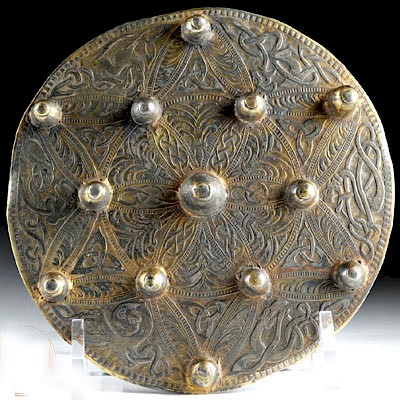Veracruz Articulated Pottery "Sonriente" Figure
Lot 96
About Seller
Artemis Gallery
686 S Taylor Ave, Ste 106
Louisville, CO 80027
United States
Selling antiquities, ancient and ethnographic art online since 1993, Artemis Gallery specializes in Classical Antiquities (Egyptian, Greek, Roman, Near Eastern), Asian, Pre-Columbian, African / Tribal / Oceanographic art. Our extensive inventory includes pottery, stone, metal, wood, glass and textil...Read more
Estimate:
$3,000 - $5,000
Absentee vs Live bid
Two ways to bid:
- Leave a max absentee bid and the platform will bid on your behalf up to your maximum bid during the live auction.
- Bid live during the auction and your bids will be submitted real-time to the auctioneer.
Bid Increments
| Price | Bid Increment |
|---|---|
| $0 | $25 |
| $300 | $50 |
| $1,000 | $100 |
| $2,000 | $250 |
| $5,000 | $500 |
| $10,000 | $1,000 |
| $20,000 | $2,500 |
| $50,000 | $5,000 |
| $100,000 | $10,000 |
| $200,000 | $20,000 |
About Auction
By Artemis Gallery
Jul 19, 2018
Set Reminder
2018-07-19 10:00:00
2018-07-19 10:00:00
America/New_York
Bidsquare
Bidsquare : Fine Antiquities/Ethnographic Art
https://www.bidsquare.com/auctions/artemis-gallery/fine-antiquities-ethnographic-art-3329
Featuring classical antiquities, ancient and ethnographic art from cultures encompassing the globe, plus fine art. Artemis Gallery info@artemisgallery.com
Featuring classical antiquities, ancient and ethnographic art from cultures encompassing the globe, plus fine art. Artemis Gallery info@artemisgallery.com
- Lot Description
Pre-Columbian, Mexico, Gulf Coast, Veracruz, Classic Period, ca. 100 BCE to 900 CE. An amazing hollow, molded, terracotta standing figure with separately made articulated arms. The molded detail shows a fine laughing face with almond shaped eyes, a small nose, and a wide-open mouth. The mouth is parted to reveal teeth. The face is painted yellow, with red around the eyes and on top of the headdress. The headdress itself is a work of art, large, with a crest that appears to mimic the shape of feathers down its center; two applied curves are on either side of the crest. Round, decorated earrings are carved at the ears, and have a fantastic level of detail. The torso and limbs are equally well-rendered. The figure also wears a necklace and a belt, and has exposed male genitalia. Size: 6" W x 11.5" H (15.2 cm x 29.2 cm); 11.75" H (29.8 cm) on included custom stand.
This type of figure is known as a sonriente. Sonrientes, or "smiling faces", are the most famous pottery from this period in Veracruz (known as Remojadas for its keystone archaeological site). Like this one, they depict wide, smiling, childlike faces, often with teeth showing. Smiling faces are very rare in Mesoamerican art, but in Remojadas and the surrounding area, there are thousands of these Sonrientes figures, leading to a mystery for archaeologists. Some have suggested that the smiles are the result of consuming the alcoholic beverage pulque, or taking hallucinogenic drugs; others see them as representing performers.
Provenance: private Hawaii, USA collection; ex T. Misenheimer collection
All items legal to buy/sell under U.S. Statute covering cultural patrimony Code 2600, CHAPTER 14, and are guaranteed to be as described or your money back.
A Certificate of Authenticity will accompany all winning bids.
We ship worldwide and handle all shipping in-house for your convenience.
#132619Repaired and restored from multiple pieces, with overpainting of restored areas, specifically the chest and one leg. The head and face are in nice condition above the neck, with fine remaining pigment.Condition
- Shipping Info
-
All shipping is handled in-house for your convenience. Your invoice from Artemis Gallery will include shipping calculation instructions. If in doubt, please inquire BEFORE bidding for estimated shipping costs for individual items.
-
- Buyer's Premium



 EUR
EUR CAD
CAD AUD
AUD GBP
GBP MXN
MXN HKD
HKD CNY
CNY MYR
MYR SEK
SEK SGD
SGD CHF
CHF THB
THB
















